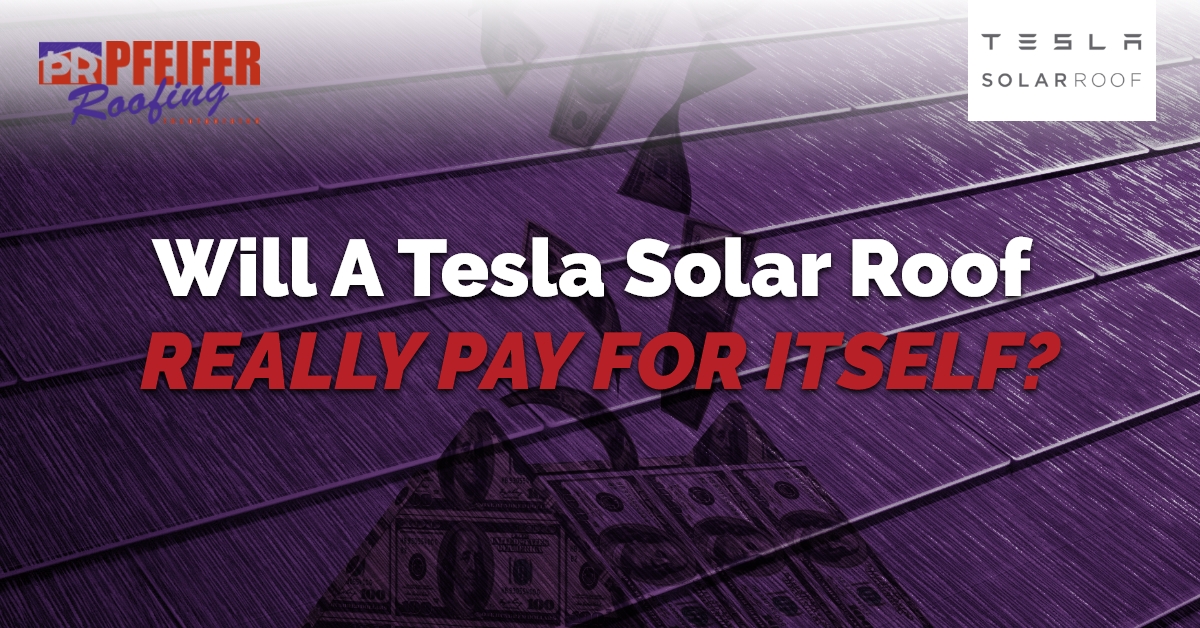Roof replacement is often expensive, regardless of which materials you choose. So, as you look over roof options and see that a Tesla Solar Roof is one of the most costly, you may be tempted to just cross it off the list. If your goal is to save money long-term, this would be a mistakes. Although it comes at a higher up-front cost than most roofs, the Tesla Solar Roof saves homeowners money over time.
The Payoff Period
One of the most common questions we get about the Tesla Solar Roof is “how long will it take to pay for itself?” The short answer is 7 – 13 years.
If you live in a sunny climate and your roof can generate electricity year-round, you’ll be on the shorter end of this range. If you live in a climate with more cloudy days, it may take your Tesla Solar Roof closer to 13 years to pay for itself.
The important point here is that, regardless of how long it takes, a Tesla Solar Roof will pay for itself — and in significantly less than the 25 years it is warrantied for. Once the roof pays for itself, the additional savings are just money earned!
How a Tesla Roof Saves Money
The payoff period for a Tesla Solar Roof is so short because these systems save you money in a few different ways.
Lower Utility Bills
Every kW of electricity your Tesla Solar Roof produces is one you don’t have to pay for. Many Tesla Solar Roofs actually produce more electricity than the homeowner can use. In this case, the excess electricity gets fed back into the power grid.
A meter keeps track of how much electricity you send into the grid. If you send more than you draw, your electricity company won’t send you a bill. Instead, they’ll send you a check for the power you shared. A few years’ worth of checks versus bills from the power company can quickly negate the higher cost of a Tesla Solar Roof.
Less Maintenance
Almost every type of roof requires some maintenance. Tile roofs need to be carefully washed to remove algae and prevent additional algae growth. Metal roofs need to be rinsed to remove salt and road debris that can accelerate the rate of corrosion. The cost of this maintenance can add up quickly.
One unique thing about the Tesla Solar Roof is its low maintenance requirements. The roof is specially made to be slick and slippery. Every time it rains, the rain water will automatically rinse any debris off the roof surface. This ensures the solar panels stay clean and able to harness sunlight. With a Tesla Solar Roof, there’s no scrubbing, spraying, or power washing required. This translates to some pretty substantial maintenance savings over time.
No Need for a Generator
If you pair your Tesla Solar Roof with a Tesla Powerwall, you won’t need to buy or maintain a generator. When the public power goes out, your home will draw electricity from the Powerwall. So, you can cross the cost of a generator off your list of expenditures. That’s a few thousand dollars more you can put towards your Tesla Solar Roof.
Tax Credits and Your Tesla Solar Roof
You can also reduce the initial cost of your Tesla Solar Roof by applying for relevant tax credits. In 2006, the federal government began offering a Federal Residential Solar Energy Credit. This credit was initially due to expire in 2020, but Congress elected to extend it until 2024. At that time, Congress has the option to renew it again.
This tax credit is substantial. Homeowners can receive 26% of the cost of a system installed between 2020 and 2022. They can receive 22% for any system installed in 2023. There’s no maximum amount that can be claimed. So, regardless of how much you pay for your Tesla Solar Roof, the federal government will send you 22-26% of that amount back in the form of a tax credit.
There are restrictions as to who is eligible for this credit, but they’re pretty lax. Most homeowners qualify. To qualify, your system must be installed before December 31st, 2023. You must install the solar system at your primary or secondary residence, and you must own the system yourself. These tax credits cannot be applied to used photovoltaic equipment or rentals. By the time you take tax credits, utility savings, and maintenance costs into account, a Tesla Solar Roof will pay for itself before you know it. If you’d like to schedule an estimate and get a better idea of exact costs, contact Pfeifer Roofing in Salem, Oregon. As a Tesla Installer, we’re happy to answer all of your questions about this innovative, money-saving roof system.

